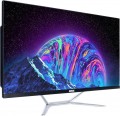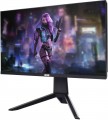Resolution
Resolution of the screen installed in the monoblock (see "Type").
The higher the resolution, the clearer and more detailed image the screen can produce, but the more expensive it is. In addition, high resolutions require corresponding powerful graphics, which further affects the price of the entire computer. The minimum indicator for modern monoblocks is actually 1366x768 — this resolution allows, in particular, to play HD 720p video in proper quality. However, nowadays, the more advanced format is most widely used —
Full HD, providing a resolution of 1920x1080. And in high-end monoblocks with a large diagonal and powerful graphics, there are also more solid resolutions —
Quad HD(2560x1440, 3440x1440),
Ultra HD 4K(3840x2160, 4096x2304) and even
5K(5120x2880) standards.
Panel type
The type of matrix used in the monoblock screen (see "Type").
—
TN+film. The simplest and most inexpensive type of modern matrices. In addition to low cost, the advantages of TN + Film include good speed (short response time). But the overall picture quality can be described as average: in terms of brightness, colour gamut and colour reproduction quality, screens of this type are noticeably inferior to more advanced options. However this quality is quite enough for relatively simple tasks like surfing the web or working with documents, and in most cases even for playing games and watching movies; however, TN-Film screens are not suitable for professional work with colour.
—
IPS. A variety of matrices designed for high image quality. In terms of brightness and colour fidelity, such screens are indeed far superior to TN-film, making them excellent for professional use. In addition, these properties are valued among demanding gamers and movie fans. The response time in early versions of IPS screens was quite high, but in modern versions this feature is almost eliminated. But the unequivocal disadvantage of such screens is the rather high cost. Also note that nowadays on the market there are several varieties of IPS, differing in characteristics. For example, E-IPS is a relatively simple and inexpensive option, P-IPS and H-IPS are professional (when they were created, maximum attention was
...paid to colour reproduction), and AH-IPS was developed with an eye on ultra-high resolution screens. So it would not hurt to clarify the specific features of such a screen separately — especially if a monoblock is bought for design, photo processing and other similar tasks that involve careful work with colour.
— pls. In fact, one of the versions of the IPS technology described above, created by Samsung. During development, special attention was paid to both improving performance and reducing the cost of the matrix; in the end, according to the creators, they really managed to achieve higher brightness and contrast, combined with a lower cost. In general, the characteristics are comparable to mid-level versions of IPS.
— *VA. Various versions of VA technology — Fujitsu's MVA, Samsung's PVA and Super PVA, Sharp's ASVA, etc.; In general, there are no key differences in design between these versions. The *VA technology itself was created as a compromise between the speed and affordability of TN-Film matrices and the high-quality "picture" of IPS. The result is screens with more accurate and complete colour reproduction than TN, with good blacks and good viewing angles; the response speed was initially not very high, but in modern versions this drawback has been practically eliminated. At the same time, a feature of *VA screens is that the colour balance of the visible image depends on the viewing angle and changes with the slightest deviation from the perpendicular. With normal PC use, this phenomenon is almost imperceptible, however, such monitors are still poorly suited for professional work with colour.Graphics card model
The main manufacturers of video cards nowadays are
AMD,
NVIDIA and Intel, and each has its own specifics. NVIDIA produces primarily discrete solutions; Among the most common are
the GeForce MX1xx,
GeForce MX3xx,
GeForce GTX 10xx series (in particular
GTX 1050,
GTX 1050 Ti and
GTX 1060),
GeForce GTX 16xx,
GeForce RTX 20xx,
GeForce RTX 30xx(
GeForce RTX 3060,
GeForce RTX 3060 Ti,
GeForce RTX 3070,
GeForce RTX 3070 Ti,
GeForce RTX 3080,
GeForce RTX 3080 Ti, GeForce RTX 3090,
GeForce RTX 3090 Ti),
GeForce RTX 4060 , GeForce RTX 4060 Ti,
GeForce RTX 4070,
GeForce RTX 4070 SUPER,
GeForce RTX 4070 Ti,
GeForce RTX 4070 Ti SUPER,
Ge Force RTX 4080,
GeForce RTX 4080 SUPER,
GeForce RTX 4090 and separate
Quadro series. AMD offers both discrete and integrated graphics - including the popular
Radeon RX 500,
Radeon RX 5000,
Radeon RX 6000 and
AMD Radeon Pro series. And Intel deals exclusively with modules integrated into processors of its own production - these can be HD Graphics, UHD Graphics and Iris.
Note that many configurations with discrete graphics also have an integrated graphics module; in such cases, the name of the discrete video card is indicated as more advanced.
3DMark
The result shown by the PC graphics card in the 3DMark test (benchmark).
3DMark is a specialized test designed primarily to test the performance and stability of a graphics card in demanding games. The verification is carried out by running 3D videos created on various game engines using various technologies. The final result is evaluated both in terms of frame rate and in conditional points; in this paragraph, just the number of points is given. The higher it is, the more powerful and performant the graphics card is.
Note that 3DMark testing can be carried out for any type of graphics (see "Graphics card type"). At the same time (as of 2020) in integrated solutions, the final result rarely exceeds 1000 points; the most modest indicator for discrete adapters is about 1700 points; and in some high-end graphics cards, it can exceed 10,000 points.
Passmark G3D Mark
The result shown by the PC graphics card in the test (benchmark) Passmark G3D Mark.
Passmark G3D Mark is a comprehensive test to check the performance of a graphics card in various modes. Traditionally for such tests results are displayed in points, more points mean (proportionately) higher computing power. However, note that the graphics card is tested in different modes, and the final score is derived based on several results in specialized tests. Therefore, adapters with a similar overall result may differ slightly in actual performance in certain specific formats of operation. So if a PC is purchased for professional work with graphics, and high efficiency in some specialized tasks is critical, it will not hurt to clarify these nuances separately.
Note that with the help of Passmark G3D Mark, nowadays, all types of graphics adapters are tested (see "Graphics card type"). At the same time, for integrated solutions, a result of more than 1200 points is considered very good, and in discrete models this figure can vary from 2200 – 2300 points to 20,000 points or more.
Monitors connection
The maximum number of monitors that can be connected to PC at the same time and shared.
Simultaneous connection of several screens allows you to expand the visual space available to the user. For example, it can be useful for designers and layout designers when working with large-format materials, for programmers to separate tasks (one monitor for writing code, the second for searching for the necessary information and other auxiliary purposes), and for gamers-enthusiasts — to ensure the maximum immersion effect.
Built-in microphone
The presence of a PC microphone built directly into the case.
This function is found only among monoblocks (see "Type") — it does not make sense in other types of computers, you need to use external microphones with them. The characteristics of the built-in microphone are usually quite modest: they are enough for comfortable voice communication, for example, via Skype, but for more serious tasks (even for amateur recording of a song with a guitar) it is better to use separate devices with higher sound quality.
Webcam
The PC has its own built
-in webcam.
Such a camera can be used for video communication, online streaming, recording amateur videos, etc. The optimal place for its placement is above the computer screen. Therefore, only monoblocks are equipped with built-in "webcams" — in other models there is simply nowhere to install the camera. Note that the characteristics of such an "eye" can be quite modest, and for more or less high-quality video recording or broadcasting, you may still need a separate webcam. Therefore, there are also
monoblocks without a camera.
Lighting type
The type of backlight provided in the design of the PC. Indicated by the part of the computer that is actually highlighted; most often this is the case, but other places of installation are possible, for example, cooling fans.
Anyway, this feature does not affect the functionality of the PC, but gives it an original and stylish appearance. This is especially appreciated by gamers, so most of the backlit configurations are just for gaming (see "Type"). The most advanced backlight systems may provide the ability to change colour and/or synchronize with other system components and peripherals.

